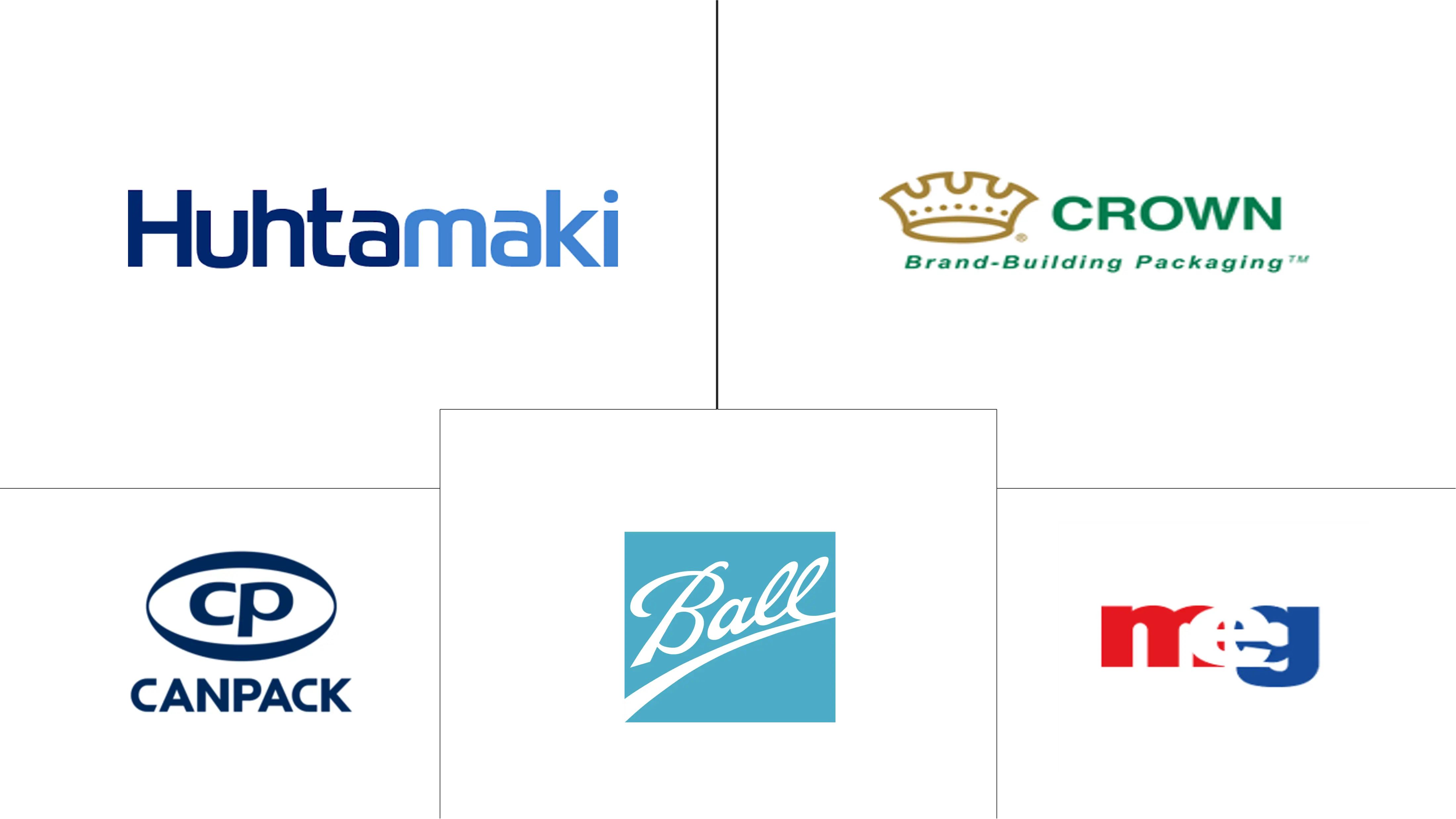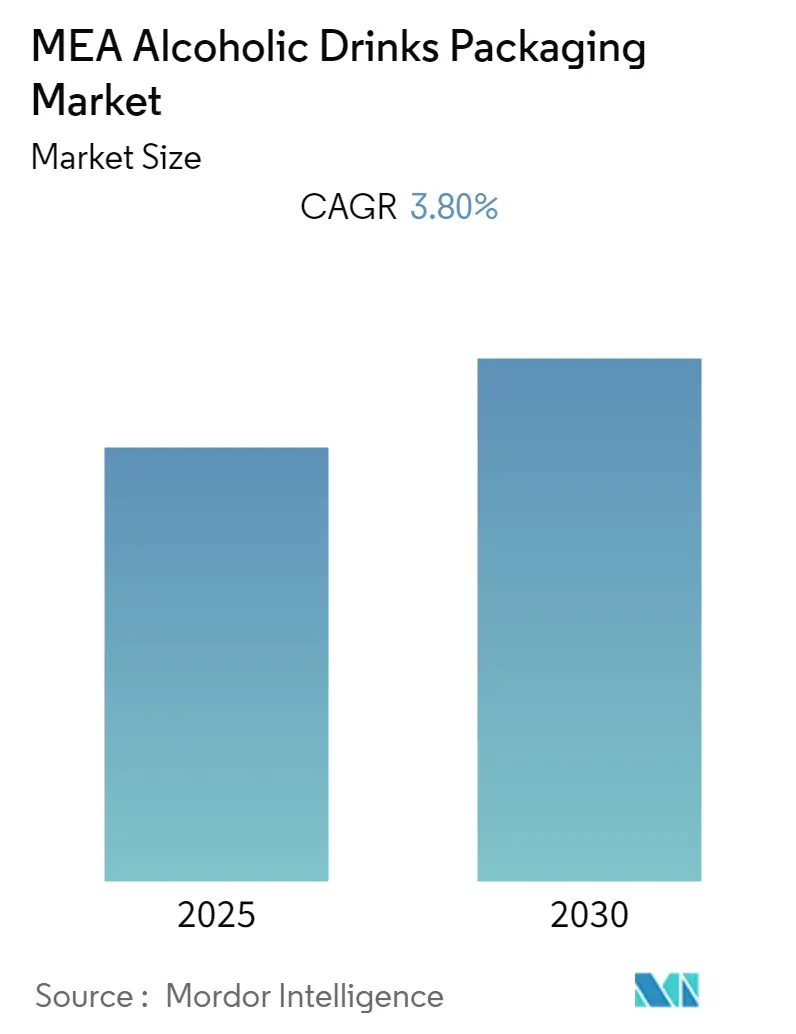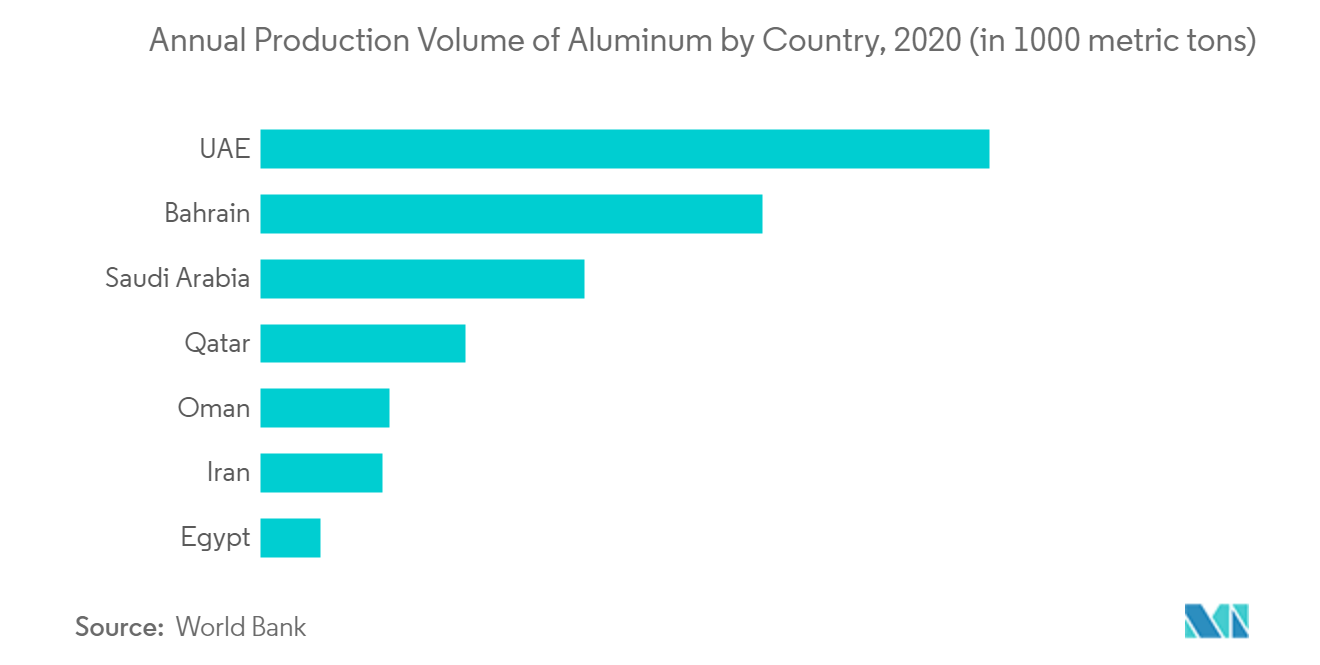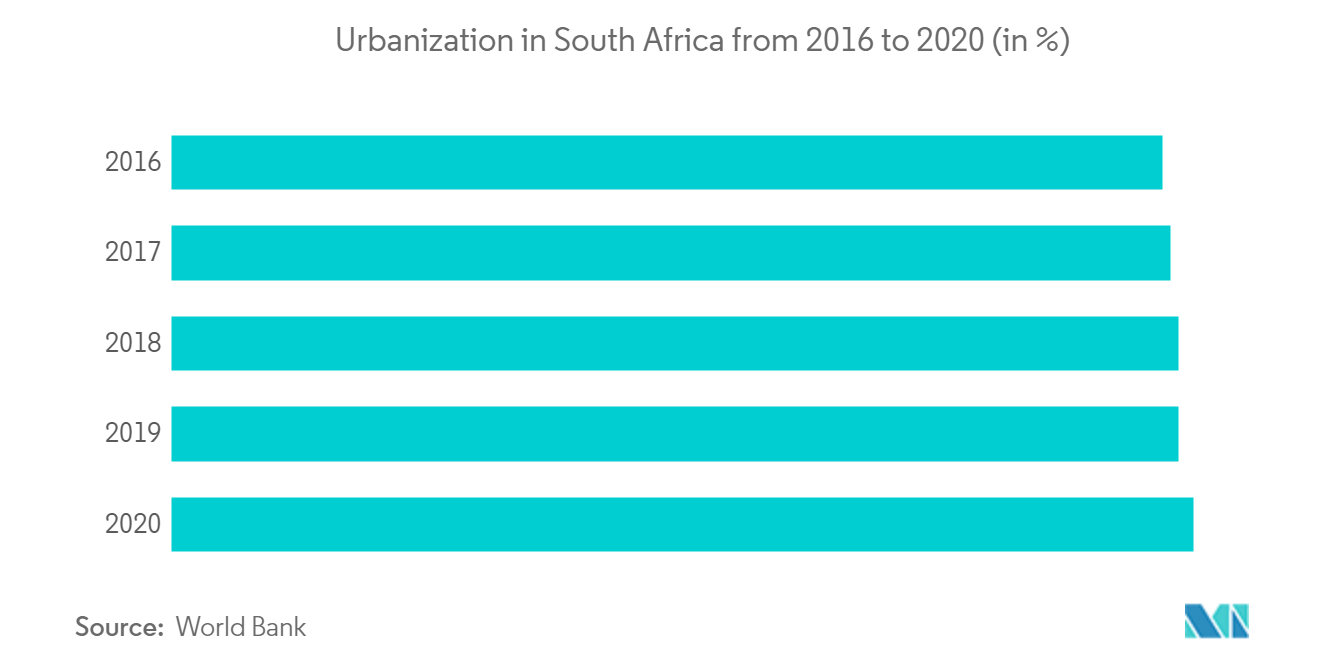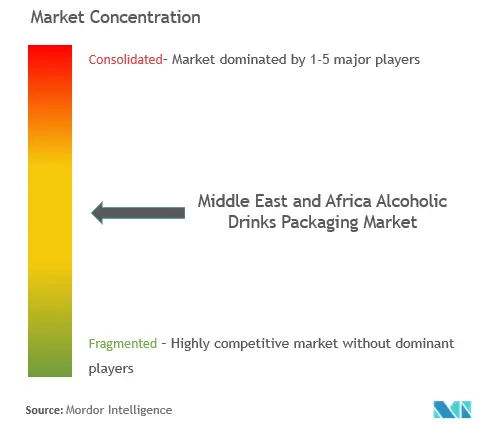MEA Alcoholic Drinks Packaging Market Analysis
The MEA Alcoholic Drinks Packaging Market is expected to register a CAGR of 3.8% during the forecast period.
- According to USDA Foreign Agricultural Service, South Africa's wine grape production was projected to increase marginally by 1% to 1.25 million metric tons in 2020. The irrigation facilities are improving with favorable weather conditions and improved yields, and some regions also recovered from the 2016-2018 drought conditions. Wine production was projected to reach 947 million liters in 2020. While the South African wine industry is showing signs of rebounding, it also faces threats from imports of low-value wine suppliers and rising stocks.
- There has been a mixed impact of the COVID-19 pandemic on the alcoholic drinks market in the region. For instance, in South Africa, during the lockdown, transportation and sale of alcoholic drinks were banned entirely within the country, meaning that on-trade sales could not simply move into the off-trade during the period of on-trade closures. However, in the United Arab Emirates, due to the continued availability of the products and supply chain resilience, the market has seen increased purchases in off-trade outlets for home consumption. Sales of non-alcoholic beer, the only category present in alcoholic drinks in Saudi Arabia, declined throughout 2020 as the COVID-19 pandemic led to the government-mandated closure of all on-trade establishments.
- Alcohol-free alternatives of beer, wine, and spirits offer a premium trade-up alternative for consumers in the Middle Eastern markets where alcohol is banned. Such innovations may also suit the market where alcohol consumption is restricted. Saudi Arabia was one of the largest markets for alcohol-free beer consumption globally. Volume consumption of non-alcohol beer almost doubled in the country between 2015 and 2019. It is expected to grow further in the future.
- In the United Arab Emirates (UAE), alcohol growth is majorly contributed by tourism and its vast expatriate population. Emiratis make up 10% of the people, while expatriates account for 90%. According to the World Health Organization, spirits were the most popular alcohol in the United Arab Emirates, with a share of 82%, followed by beer (10%) and wine (8%).
- Furthermore, the United Arab Emirates made new laws and removed punishments for the consumption, sales, and possession of alcohol for those 21 years and over. The easing of alcohol restrictions is part of an overhaul of the country's Islamic personal laws. Relaxing personal regulations aim to "consolidate the UAE's principles of tolerance." This move reflects the country's changing reputation as a hub for international tourism and business. These changes will boost the consumption of alcoholic beverages in the region.
MEA Alcoholic Drinks Packaging Market Trends
Metal Can Packaging is Expected to Grow Significantly
- In Turkey, the demand for metal beverage cans has increased in the beer segment. The share of metal cans in domestic lager is growing rapidly, accounting for just under half of the total volume share. The price difference between beer in glass bottles and metal beverage cans drives the sales of cans.
- Wine in a can is a new trend penetrating the South African wine packaging market, with winemakers introducing canned versions of their popular offerings. For example, local player Perdeberg Wines has launched a 250ml can format of its Soft Smooth Red range, with the pack featuring a striking zebra-print design.
- In the United Arab Emirates, many brands are increasingly offering their products in metal beverage cans. All imported brands use this type of packaging, with a beer in the 330 ml format in a 24-pack being cheaper than the equivalent packaging for glass bottles. Brands offer smaller size packages for testing new spirits.
- A growing preference for metal cans is expected to be seen in the non-alcoholic beer segment. A non-alcoholic beer brand, Barbican, is driving this trend by shifting from glass packaging to metal cans with refreshing designs for its pomegranate, apple, and strawberry flavors.
The South African Market is Expected to Grow Significantly
- In the last decade, while the country's beer fans embraced Pale Ales and Lagers, the reach of local sorghum-based beer remained limited to rural areas. Also, homebrewed and commercial sorghum beer is often sold in unhygienic and unsafe packaging that is not tamper-proof. However, a few of South Africa's new microbreweries recently started to turn sorghum-based beer into their modern recipes. They also introduced paper-based packaging 'conical cartons' for this beer, which are sealed pack cartons. Therefore, this type of packaging ensures retailers' and consumers' trust regarding the quality of the beer inside a sealed carton.
- The sustainability trend is gaining traction among consumers and major players in the alcoholic drinks market. Recently, South African Breweries launched its new Cold Lock secondary packaging for its Castle Lite range that claims to keep the beer colder for longer without using ice after refrigeration.
- According to #BizTrends2020, the premium rum trend gained momentum in the country. Champagne and Cognac will continue to be popular as the population of black middle-class increases in South Africa. The rise of sparkling wine continues as consumers develop a taste for premium and imported wines. With the severe economic pressure faced by consumers, ready-to-drink (RTD) and international beers may continue to drive category growth as consumers use the international brand credentials and accessible price points to differentiate themselves from their peers.
- During COVID-19, the declining consumer purchasing power and reduced disposable incomes drove the emergence of larger value-for-money packaging. For instance, the 1 liter Carling black label size recorded strong growth, albeit from a low base.
MEA Alcoholic Drinks Packaging Industry Overview
The availability of several players providing packaging solutions for alcoholic beverages has intensified the competition in the market. Therefore, the Middle-East and African alcoholic drinks packaging market is moderately fragmented, with many companies developing expansion strategies. Some of the recent developments are:
- June 2021 - Can-Pack collaborated with SSHS Group Hungary to give its Regenera brand a gentle, modern, premium look and feel for its can using subtle color with a matte finish. Regenera is a fruit-flavored, functional drink made from herbal extracts that aim to combat the side effects of hangovers.
MEA Alcoholic Drinks Packaging Market Leaders
-
Huhtamäki Oyj
-
Ball Corporation
-
Crown Holdings Inc.
-
Middle East Glass Manufacturing Co SAE
-
Can-Pack SA
- *Disclaimer: Major Players sorted in no particular order
MEA Alcoholic Drinks Packaging Market News
- August 2021 - Huhtamäki Oyj acquired Elif Holding AŞ, a major supplier of sustainable, flexible packaging to global FMCG brand owners, with operations in Turkey and Egypt. In line with Huhtamaki's 2030 growth strategy, the acquisition adds scale in strategic geographies and supports Huhtamaki's progress toward reaching its high sustainability ambitions. The acquisition also expands Huhtamaki's technology capabilities and product range, allowing it to serve its customers even better.
- August 2021 - Ball Corporation is leading the way in packaging innovation to achieve sustainability by lowering reliance on plastic and glass. It is working hard to make aluminum a safer alternative to plastic to solve the growing problem of single-use plastic in industries such as drinks, aircraft, household items, food, and others.
MEA Alcoholic Drinks Packaging Industry Segmentation
Alcoholic beverage packaging plays a prominent role in brand promotion, increasing brand visibility. At present, the alcohol beverage manufacturers are ardent about providing top packaging standards for their products to influence the consumers to purchase their brand over another. The report offers a brief understanding of the packaging products used for alcoholic beverage packaging in the Middle-East and Africa. The various packaging products considered for the study are bottles, metal cans, cartons, and pouches, which use different packaging materials, such as plastic, paper, metal, and glass.
| By Primary Material | Glass |
| Metal | |
| Plastic | |
| Paper | |
| By Alcoholic Products | Wine |
| Spirits | |
| Beer | |
| Other Types of Alcoholic Beverages | |
| By Product Type | Glass Bottles |
| Metal Cans | |
| Plastic Bottles | |
| Other Product Types | |
| By Country | United Arab Emirates |
| South Africa | |
| Egypt | |
| Turkey | |
| Rest of Middle-East and Africa |
MEA Alcoholic Drinks Packaging Market Research FAQs
What is the current MEA Alcoholic Drinks Packaging Market size?
The MEA Alcoholic Drinks Packaging Market is projected to register a CAGR of 3.8% during the forecast period (2025-2030)
Who are the key players in MEA Alcoholic Drinks Packaging Market?
Huhtamäki Oyj, Ball Corporation, Crown Holdings Inc., Middle East Glass Manufacturing Co SAE and Can-Pack SA are the major companies operating in the MEA Alcoholic Drinks Packaging Market.
What years does this MEA Alcoholic Drinks Packaging Market cover?
The report covers the MEA Alcoholic Drinks Packaging Market historical market size for years: 2019, 2020, 2021, 2022, 2023 and 2024. The report also forecasts the MEA Alcoholic Drinks Packaging Market size for years: 2025, 2026, 2027, 2028, 2029 and 2030.
Our Best Selling Reports
MEA Alcoholic Drinks Packaging Industry Report
Statistics for the 2025 MEA Alcoholic Drinks Packaging market share, size and revenue growth rate, created by Mordor Intelligence™ Industry Reports. MEA Alcoholic Drinks Packaging analysis includes a market forecast outlook for 2025 to 2030 and historical overview. Get a sample of this industry analysis as a free report PDF download.

